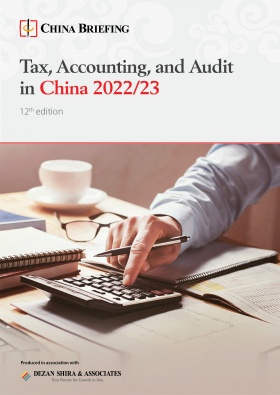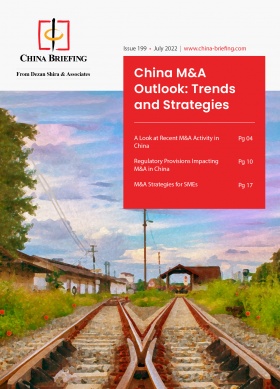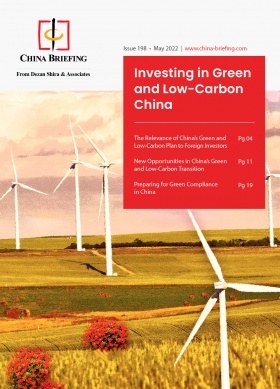20th Party Congress Report: What it Means for Business, the Economy, and Social Development
On October 16, the first day of the week-long 20th Party Congress of the Chinese Communist Party, President Xi Jinping delivered the 20th Party Congress report. The report, which is a summary of the speech Xi Jinping gave on the first day of the congress, looks back upon the achievements since the previous congress and earlier, and outlines the country and the party’s underlying policy agenda for the following five-year term.
Despite no new policies being announced, the report clarifies the priorities for China going forward and sets some concrete targets for 2035 and mid-century. It also spells out key tasks and principles in a broad range of fields, from governance, foreign policy, business environment, social development, talent cultivation, and climate and environment, among many others.
In this article, we look at how the report sheds light upon China’s development trajectory across five key areas: foreign investment and market opening, technological development, green development and climate targets, social welfare and development, and COVID-19.
Long-term goals
The long-term goal set forth in the report is to “comprehensively build a powerful modern socialist country”. This goal is to be achieved in two phases: basically achieving modern socialism from 2020 to 2035 and building a great modern socialist country that is “prosperous, strong, democratic, culturally advanced, harmonious, and beautiful” from 2035 to 2050.
The report provides a more granular explanation for the 2035 target. Below, we have summarized the targets that relate to economic and industry development:
By 2035, China’s overall development targets include:
- Achieve a per capita GDP level of a moderately developed country;
- Achieve high-level scientific and technological self-reliance and be at the forefront of innovative countries;
- Build a modern economic system, form a new development pattern, and basically realize new industrialization, informatization, urbanization, and agricultural modernization;
- Build a strong country in education, science and technology, talent, culture, sports, and healthy China, and significantly enhance China’s soft power;
- Increase the per capita disposable income of residents, significantly increase the proportion of middle-income groups, make basic public services equal, and ensure rural areas have access to modern living conditions;
- Form green production and lifestyles, stabilize and decrease carbon emissions after reaching peak emissions (in 2030), and fundamentally improve the ecological environment.
The report also provides general goals for the next five-year term. The targets are not concrete in nature and generally are steps toward achieving the 2035 targets. They include:
- Improving self-reliance in science and technology;
- Matching the growth of residents’ income with economic growth;
- Matching the increase in labor remuneration with the increase in labor productivity;
- Making basic public services more equal;
- Taking a step toward completing the multi-level social system; and
- Significantly improving the urban and rural living environment.
Foreign investment and market opening
The report makes a few references to foreign investment, businesses, and market opening, and though it does not provide new information on related policies, it still underscores China’s basic position of continued market opening. It also underlines that foreign investment and businesses will continue to have an important role in China’s future development in a few key ways.
First, the report calls for implementing a “more active opening strategy”. This will include building a network of high-standard free trade zones (FTZs) and accelerating the construction of pilot FTZs and the Hainan Free Trade Port (FTP).
The report also states that China has become the largest trading partner for over 140 countries and regions and is the number one destination for foreign direct investment (FDI) in the world, clearly illustrating the importance of foreign trade and investment to the country.
Second, the report makes it clear that foreign investment and business will be a core tenant of the country’s “high-quality development”, which in itself was an important component of the report.
The report mentions the role of foreign investment and business in the scope of China’s “dual circulation” strategy, through which China will strive to “attract global resources with the domestic cycle, enhance links between domestic and international markets, and improve the quality and level of trade and investment cooperation”.
Other proposed measures to promote foreign trade and investment mentioned in the report include:
- Steadily expanding the institutional opening of rules, regulations, management, and standards; and
- Optimization and upgrading of trade in goods, innovating the development mechanism of trade in services, developing digital trade, and accelerating the construction of a trade powerhouse.
The report reiterates efforts to improve the investment environment for foreign businesses and investors, with measures including:
- Reasonably reducing the negative list for foreign investment access;
- Protecting the rights and interests of foreign investors in accordance with the law;
- Creating a market-oriented, legalized, and international first-class business environment;
- Accelerating the construction of the Hainan FTP and expanding the global network of high-standard FTZs; and
- Promoting the internationalization of the RMB.
Another aspect of achieving “high-quality development” is to improve the business environment more generally, which in turn will also benefit foreign investors and businesses. Though only briefly mentioned, the report calls for “deepening the reform of streamlining administration and delegating powers, combining delegating power with regulation, and optimizing services”. This is essentially a pledge to continue with the fangguanfu campaign to reduce administrative red tape and delegate more decision-making abilities to lower-level governments.
Along similar lines, the report also calls for the continuation of other efforts and campaigns to optimize the business environment, including more support for small and medium-sized enterprises, improving intellectual property rights (IPR) protection, fair competition, and strengthening China’s anti-monopoly and anti-unfair competition capabilities.
Finally, the report stresses the importance of “high-quality opening”, which means actively encouraging foreign investment in areas that will help China achieve its core development goals. These, as we discuss in more detail below, include improving China’s scientific and technological self-reliance and innovation capabilities, as well as rebalancing development across different regions. Foreign companies and investors that are active in these areas, in particular, if they seek to invest in inland areas in the west and northeast, will continue to be welcome.
Rebalancing development
A key development goal that has received increased attention over the past few years is the rebalancing of development across different regions in China. This rebalancing act will include efforts to move certain industries from the wealthier and more developed eastern and coastal regions to the western and central regions, as well as further growing key industries in these less developed areas.
The report brings up the importance of this task again, stating that China will “promote coordinated regional development”. Among other tasks, this will involve promoting the development of the western regions, “comprehensive revitalization” of the northeastern regions, accelerating the rise of the central regions, and encouraging the eastern regions to accelerate modernization.
It also explicitly calls for the continued development of China’s mega-city clusters, in particular the Xiongan New Area of the Beijing-Tianjin-Hebei economic cluster and the Chengdu-Chongqing economic circle.
Technology
Talent
One of China’s key development goals – which the report also lists as one of the main development targets for the mid-21st century – is to achieve scientific and technological self-sufficiency. The report itself doesn’t go into too much detail on how technological self-sufficiency will be quantified, but it does make a clear case for one of the key ways that it expects to achieve it: by cultivating science and technology talent.
The report dedicates an entire chapter to the cultivation of tech talent, which underlines the importance of science and technology education and support for talent. The report states that “science and technology are the primary productive force, talents are the primary resource, and innovation is the primary driving force [for building a modern socialist country]”.
Among the various goals for improving China’s science and technology talent pool, the report also calls for “strengthening the international exchange of talent”, indicating that China will continue to seek high-level foreign talent for strategic industries.
Education
The report places a high level of importance on education as a means for increasing science and technology talent, calling for, among other things, making education in urban and rural areas more equal and improving the student funding system of all school levels (currently, the nine years of compulsory schooling are funded by the state).
Considerable emphasis is also placed on the role of vocational education, with the report calling for more collaboration in innovation between vocational education, higher education, and further education, as well as promoting the integration of industry and education and optimizing the positioning of vocational education. Finally, the report also raises the role of private education in the realm of science and technology, although it does not provide specifics.
Innovation
The report calls on improving innovation to increase China’s standing in terms of technological and scientific innovation and achieving self-sufficiency in these fields.
Among other measures, it calls for promoting the construction of international science and technology innovation centers, increasing investment in “diversified science and technology”, strengthening IPR, and expanding international science and technology cooperation and exchange.
In terms of improving China’s innovation capabilities, the report also encourages “originality and free exploration”, and calls for creating a favorable environment for the growth of small and medium-sized enterprises (SMEs) in the science and technology fields.
Green development
The two periods of development outlined in the report – from 2020 to 2035 and 2035 to 2050 – will witness China’s efforts to reduce its carbon emissions and achieve its “dual carbon” goals. The next five-term will also put the country on track toward achieving the first of these goals: reaching peak carbon emissions by 2030.
The report reiterates China’s commitment to improving the environment and reducing carbon emissions, stating unequivocally that “nature is the basic condition for human survival and development”.
To this end, the report calls for:
1. Accelerating the “green transformation” of the development mode; that is, promoting green and low-carbon economic and social development.
Specific measures include (but are not limited to):
- Improving the fiscal, tax, financial, investment, price policies and standard systems that support green development;
- Accelerating the research and development, promotion, and application of advanced technologies for energy conservation and carbon reduction; and
- Advocating green consumption, and promoting the formation of green and low-carbon production methods and lifestyles.
2. Deepening the prevention and control of environmental pollution.
This will involve (among other tasks):
- Adhering to precise, scientific, and law-based pollution control, scientific pollution control;
- Strengthening the coordinated control of pollutants and basically eliminating heavily polluted weather;
- Coordinating the management of water resources and promoting the ecological protection and management of important rivers, lakes, and reservoirs, and basically eliminating urban polluted bodies of water;
- Strengthening the prevention and control of soil pollution sources and carrying out new pollutant treatment; and
- Fully implementing the pollutant discharge permit system and improving the modern environmental management system.
3. Improving diversity, stability, and sustainability of ecosystems.
Measures for improving ecosystems include:
- Accelerating the implementation of major projects for the protection and restoration of important ecosystems;
- Promote the construction of a natural reserve system with national parks as the main body;
- Implementing major biodiversity conservation projects;
- Carrying out large-scale land greening campaigns;
- Promoting the regeneration of grasslands, forests, rivers, lakes, and wetlands;
- Implementing a ten-year ban on fishing in the Yangtze River;
- Improving the system of farmland fallow rotation; and
- Strengthening biosafety management and preventing the invasion of alien species.
4. Actively and steadily promote carbon peaking and carbon neutrality; or achieving China’s “dual carbon” targets.
To achieve China’s “dual carbon” targets, the report recognizes the need for systemic change in how the country’s economy is run. However, it also emphasizes China’s need to maintain energy stability, with the report stating that China must “insist on establishing first and breaking after”. This means that China will draw upon non-renewable energy sources – including coal and other fossil fuels – to meet its growing energy demand and then take a step-by-step approach to reduce reliance on these sources. For this reason, the key tasks also include “strengthening the clean and efficient utilization of coal, intensifying the exploration and development of oil and gas resources, and increasing reserves and production”.
As for further measures to reduce reliance on fossil fuels and reducing emissions, these include:
- Improving the regulation of total energy consumption and intensity, focusing on controlling fossil energy consumption, and gradually shifting to a “dual control” system for total carbon emissions and intensity;
- Promoting clean and low-carbon transformation of industry, construction, transportation, and other fields;
- Coordinating hydropower development and ecological protection;
- Actively developing nuclear power in a safe and orderly manner;
- Improving the carbon emission statistics and accounting system, and improving the carbon emission rights market trading system;
- Improving ecosystems’ carbon sink capacity; and
- Actively participating in global climate change governance.
Common prosperity
As a flagship campaign launched by Xi Jinping in August 2021, common prosperity is an important component of the 20th Party Congress report. The report sheds new light on some of the ways in which China will seek to reduce wealth inequality and balance the level of social and economic development across different regions of the country.
The report makes it clear that common prosperity is an “essential requirement” for socialism with Chinese characteristics, and that China will strive to “maintain and promote social fairness and justice, promote common prosperity for all people, and to resolutely prevent polarization”.
One of the key ways in which China will seek to achieve common prosperity is to “improve the distribution system”.
This will not necessarily mean direct income redistribution, but rather efforts to provide fairer labor remuneration, better economic opportunities, and targeted tax policies, among other strategies, to ensure better wealth distribution in the long term. The report, as well as previous information released by the government on the matter, also indicates that China will not implement a wide-ranging welfare system, and will continue to encourage hard work on the part of the individual.
Specifically, the report calls for:
- Increasing the proportion of residents’ income in the distribution of national income and increasing the proportion of labor remuneration in the primary income distribution;
- Encouraging hard work to become rich, promoting equality of opportunity, increasing the income of low-income people, and expanding the middle-income group;
- Increasing property income of urban and rural residents;
- Improving the individual income tax system;
- Standardize wealth accumulation mechanisms, protect legitimate income, regulate excessive income, and ban illegal income; and
- Guide and support companies, social organizations, and individuals that are willing and able to actively participate in public welfare and charitable undertakings.
COVID-19 and healthcare
The report does not make many references to the COVID-19 pandemic, but when it does mention it, it is clear that the position on China’s zero-COVID policy remains unchanged.
The report repeats previously used wording on the topic, writing that “we must adhere to upholding the life of people above all else” and “being unswerving in insisting on dynamic clearing”. “Dynamic clearing”, dongtai qingling, refers to the prevention strategy that strives to keep COVID-19 to a minimum by adopting dynamic prevention measures, such as widespread and regular testing, snap lockdowns, and restrictions on movement and business operations.
However, looking to the longer term, the report calls upon various measures to improve China’s healthcare system and abilities to handle epidemics more generally. For instance, the report calls on improving the ability to detect major epidemics, including improving early warning, prevention, and treatment systems.
Key takeaways from the 20th Party Congress report
One of the key takeaways from the 20th Party Congress report is that China will seek to stabilize its economy and development before embarking on any new major policy developments. The last few years have already seen the country launch several new policies, from social development to climate to market opening. As such, focus over the next months and years will continue to be placed on the current targets for the economy, industry, and society.
The report does serve an important function in highlighting some of the priorities for China over the next five-year term and beyond, and we can therefore glean some important information in terms of the country’s trajectory.
It is clear from the report that China will continue to further open markets, in particular in FTZs and FTPs such as Hainan and the mega-city clusters. In addition, as we can see from the efforts to improve market access, strengthen IPR, and increase the role of FTZs and FTPs, the government continues to see foreign investors and businesses as having an important role to play in China’s future.
It is also important to remember that the function of the report is mostly not to implement specific policies, but rather to act as guidance for policymakers and regulators over the next five years. We therefore only expect to see the full impact and implications of the 20th Party Congress report, or the outcomes of the congress as a whole, over the next few months, as the various government bodies tasked with formulating plans and policies begin to showcase their work.
About Us
China Briefing is written and produced by Dezan Shira & Associates. The practice assists foreign investors into China and has done so since 1992 through offices in Beijing, Tianjin, Dalian, Qingdao, Shanghai, Hangzhou, Ningbo, Suzhou, Guangzhou, Dongguan, Zhongshan, Shenzhen, and Hong Kong. Please contact the firm for assistance in China at china@dezshira.com.
Dezan Shira & Associates has offices in Vietnam, Indonesia, Singapore, United States, Germany, Italy, India, and Russia, in addition to our trade research facilities along the Belt & Road Initiative. We also have partner firms assisting foreign investors in The Philippines, Malaysia, Thailand, Bangladesh.
- Previous Article More Than a Hobby: Understanding the Esports Market in China
- Next Article Belt And Road Weekly Investor Intelligence #105









